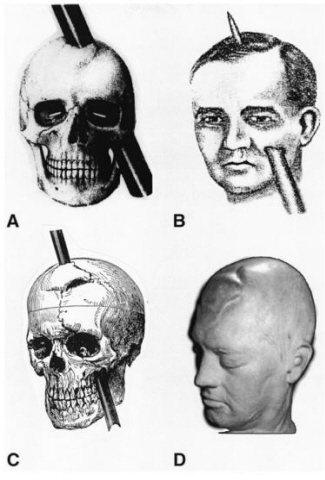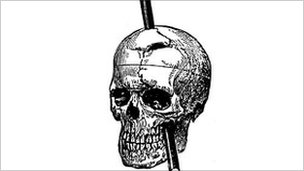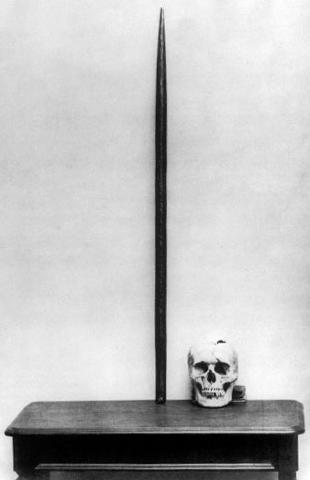| |
Phineas Gage: The man with a hole in his head |
|
 |
|
"Phineas Gage had a hole in his head, and ev'ryone knew that he oughta be dead. Was it fate or blind luck, though it never came clear, kept keepin' on year after year…"
PHINEAS GAGE (1823-1860) is one of the earliest documented cases of severe brain injury. Gage is the index case of an individual who suffered major personality changes after brain trauma. As such, he is a legend in the annals of neurology, which is largely based on the study of brain-damaged patients.
Gage was foreman of a crew of railroad construction workers who were excavating rocks to make way for the railroad track. This involved drilling holes deep into the rock and filling them with dynamite. A fuse was then inserted, and the entrance to the hole plugged with sand, so that the force of the explosion would be directed into the boulder. This was done with a crow bar-like tool called a tamping iron.
On 13th September, 1848, 25-year-old Gage and his crew were working on the Rutland and Burlington Railroad near Cavendish in Vermont. Gage was preparing for an explosion by compacting a bore with explosive powder using a tamping iron. While he was doing this, a spark from the tamping iron ignited the powder, causing the iron to be propelled at high speed straight through his skull. It entered under the left cheek bone and exited through the top of the head, and was later recovered some 30 yards from the site of the accident.
John Martin Harlow, the doctor who attended to him, later noted that the tamping iron was found "several rods [1 rod= 5.02m] behind him, where it was afterward picked up by his men smeared with blood and brain". The tamping iron was 3 ft. 8 inches in length and 1.25 inches in diameter at one end, not 1.25 inches in circumference, as reported in the newspaper report on the left. It tapered at one end, over a distance of about 1 ft., to a blunt end 0.25 inches in diameter, and weighed more than 6 kg.3

Whether or not Gage lost consciousness is not known, but, remarkably, he was conscious and able to walk within minutes of the accident. He was then seated in an oxcart, on which he was transported three-quarters of a mile to the boarding house where he was staying. Here, he was attended to by Harlow, the local physician. At the boarding house, Harlow cleaned Gage's wounds by removing small fragments of bone, and replaced some of the larger skull fragments that remained attached but had been displaced by the tamping iron. He then closed the larger wound at the top of Gauge's head with adhesive straps, and covered the opening with a wet compress. Gage's wounds were not treated surgically, but were instead left open to drain into the dressings.
Within a few days of his accident, Gage's exposed brain became infected with a "fungus", and he lapsed into a semi-comatose state. His family prepared a coffin for him, but Gage recovered. Two weeks after the accident, Harlow released 8 fluid ounces of pus from an abscess under Gage's scalp, which would otherwise have leaked into the brain, with fatal consequences. By 1st January 1849, Gage was leading an apparently normal life.
Harlow's case report of Gage's injuries appeared as a letter to the editor of the Boston Medical and Surgical Journal. The report of the "hitherto unparalleled case" contains few neurological details, and was at first met with skepticism, because it was thought that no-one could survive such an extreme injury. Harlow describes Gage's injury as follows:
[The tamping iron] entered the cranium, passing through the anterior left lobe of the cerebrum, and made its exit in the medial line, at the junction of the coronal and sagittal sutures, lacerating the longitudinal sinus, fracturing the parietal and frontal bones extensively, breaking up considerable portions of the brain, and protruding the globe of the left eye from its socket, by nearly half its diameter.
Harlow goes on to describe how, while examining Gage, he determined that no bone fragments remained inside the skull:
...in searching to ascertain if there were other foreign bodies there, I passed in the index finger its whole length, without the least resistance, in the direction of the sound [of the hemorrhaging?] in the cheek, which received the other finger in like manner.
A second report was published in 1850 by Henry J. Bigelow, a professor of surgery at Harvard University. Bigelow emphasised Gage's lack of symptoms, and reported that Gage was "quite recovered in faculties of body and mind". Because of the disbelief with which Harlow's 1848 report was met, it was, for the next 20 years, Bigelow's account that came to be generally accepted by the medical community.
Gage did, according to Harlow, retain "full possession of his reason" after the accident, but his wife and other people close to him soon began to notice dramatic changes in his personality. It wasn't until 1868 that Harlow documented the "mental manifestations" of Gage's brain injuries, in a report published in the Bulletin of the Massachusetts Medical Society:
His contractors, who regarded him as the most efficient and capable foreman in their employ previous to his injury, considered the change in his mind so marked that they could not give him his place again. He is fitful, irreverent, indulging at times in the grossest profanity (which was not previously his custom), manifesting but little deference for his fellows, impatient of restraint of advice when it conflicts with his desires, at times pertinaciously obstinent, yet capricious and vacillating, devising many plans of future operation, which are no sooner arranged than they are abandoned in turn for others appearing more feasible. In this regard, his mind was radically changed, so decidedly that his friends and acquaintances said he was "no longer Gage."
On the right is one of three figures from Harlow's 1868 paper. The legend reads:
Front and lateral view of the cranium, representing the direction in which the iron traversed its cavity; the present appearance of the line of fracture, and also the large anterior fragment of the frontal bone, which was entirely detached, replaced and partially re-united.
Thus, the damage to Gage's frontal cortex had resulted in a complete loss of social inhibitions, which often led to inappropriate behaviour. In effect, the tamping iron had performed a frontal lobotomy on Gage, but the exact nature of the damage incurred to his brain has been a subject of debate ever since the accident occurred. This is because the damage can only be inferred from the path of the tamping iron through Gage's skull, which in turn can only be inferred from the damage to the skull.
Gage's skull was damaged in three places: there is a small wound under the left zygomatic arch (cheek bone) where the tamping iron entered; another is located in the orbital bone in the base of the skull behind the orbit of the eye; and the third, and largest, wound is in the top of the skull, where the tamping iron exited. The exit wound was enormous, and never healed. It can be seen today in Gage's as an irregularly-shaped triangular hole, about 2 inches wide and 4 inches in circumference, and another, nearly 3 inches in circumference. These are separated by one of the flaps of skull that was replaced by Harlow upon arriving at Gage's boarding house. Because the circumference of the wound in the frontal bone is much larger than the maximum diameter of the tamping iron, it is difficult to determine precisely the trajectory of the iron and where it exited Gage's skull.
In 1994, Hannah Damasio and her colleagues at the University of Iowa used neuroimaging techniques to reconstruct Gage's skull. The conclusion of this study was that Gage incurred damage to both the left and right prefrontal cortices. But according to computer-generated three-dimensional reconstructions of a thin slice computed tomography scan of Gage's skull performed by Ratiu et al , the damage to Gage's brain was limited to the left hemisphere.
Nevertheless, the case of Phineas Gage made important contributions to early modern neurology. The opposition to Harlow's 1848 report was due in no small part to the popularity of phrenology at that time. The publication of Harlow's 1868 report of Gage's personality changes was significant, as it coincided with reports from other neurologists of the effects of specific lesions on behaviour.
This was a time when modern neuropsychology had begun to replace phrenology. In 1865, Paul Broca (1824-1880) described the speech centre in the left hemisphere of right-handed people; that brain region, in the inferior frontal gyrus, is now known as Broca's area. Also in the 1860s, John Hughlings-Jackson (1835-1911) and David Ferrier carried out (1843-1928) physiological studies which pointed to the localization of cerebral function.
Jackson had been the first to hypothesize that psychopathological conditions could be correlated to brain damage. He also localized the auditory cortex and in 1864, confirmed Broca's findings that, in right-handed people, speech was localized to a specific area of the left temporal lobe. Ferrier, an early proponent of the localization of cerebral function, used Gage's case as the highlight of his famous Goulstonian lecture in 1878. In the same lecture, he also described experiments on monkeys, which led him to the conclusion that:
There are certain regions in the cortex to which definite functions can be assigned; and that the phenomena of cortical lesions will vary according to their seat and also to their character...removal or destruction...of the antero-frontal lobes is not followed by any definite physiological results...And yet, notwithstanding this apparent absence of physiological symptoms, I could perceive a very decided alteration in the animal's character and behaviour, while it is difficult to state in precise terms the nature of the change...while not actually deprived of intelligence, they had lost, to all appearance, the faculty of the attentive and intelligent observation [Regarding the trajectory of the tamping iron through Gage's brain]...the absence of paralysis in this case is quite in harmony with the results of experimental physiology.
Gage's case, therefore, had confirmed Ferrier's findings that damage to the prefrontal cortex could result in personality changes while leaving other neurological functions intact. Gage's case is one of the very first which provides evidence that the frontal cortex is involved in personality. Today, the role of frontal cortex in social cognition and executive function is relatively well established; however, this area of research is yet to blossom, and neuroscientists know little more about the relationship between the mind and the brain than did the early neurologists of the 19th century.
So, what of Phineas Gage himself? Unable to return to his previous job as a foreman after his accident, Gage is said to have travelled around New England, and even to Europe, with his tamping iron trying to earn money. It is also said that he even displayed himself as a curiosity at Barnum's Museum in New York. However, the story of Phineas Gage is as much folklore as it is fact. Not only the exact nature of the neurological damage Gage sustained, but also the details of his life after the accident, are disputed to this day.
It is known that, from 1851 until just before his death, Gage worked as a coach driver, first in a livery stable at the Dartmouth Inn, in Hanover, New Hampshire, for about 18 months, and then in Chile for some 7 years. At some point in 1859, with his health deteriorating, Gage went to live with his mother. He died in San Francisco on 20th May, 1860, some 12 years after his accident, of complications arising as a result of epileptic convulsions. An autopsy on Gage's brain was not conducted.

In 1867, Gage's body was exhumed from its burial place in San Francisco's Lone Mountain Cemetery. Gage's brother-in-law took the skull and the tamping iron to Dr. Harlow, who was then living in Woburn, Massachusetts. They are now housed in the Warren Anatomical Museum at Harvard University School of Medicine.

Submit News/Videos/Links |
Discuss article |
Article Link
|
More unsolved mysteries on Unexplained Mysteries
|




![]()